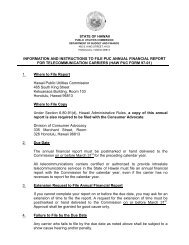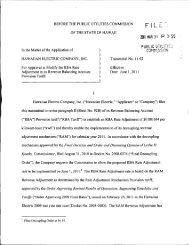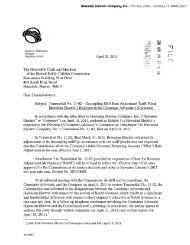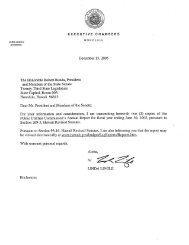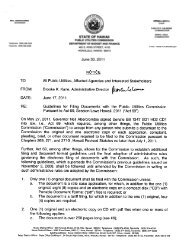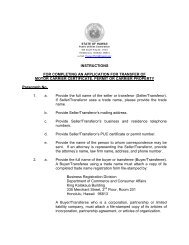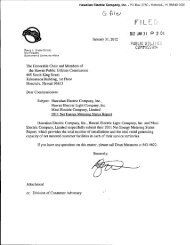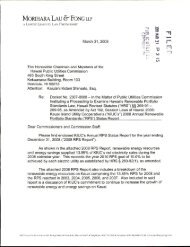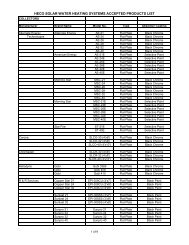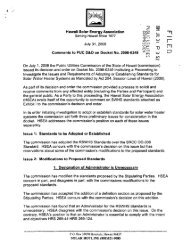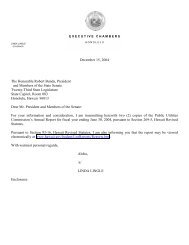PUC Annual ReportâFiscal Year 2011-12 - Public Utilities Commission
PUC Annual ReportâFiscal Year 2011-12 - Public Utilities Commission
PUC Annual ReportâFiscal Year 2011-12 - Public Utilities Commission
Create successful ePaper yourself
Turn your PDF publications into a flip-book with our unique Google optimized e-Paper software.
<strong>Public</strong> <strong>Utilities</strong> <strong>Commission</strong> <strong>Annual</strong> Report <strong>2011</strong>-<strong>12</strong><br />
State of Hawaii Page 6<br />
Regulatory Agencies (“DRA”) and the director gained the power to employ, appoint,<br />
promote, transfer, and describe <strong>Commission</strong> staff, renaming the staff the <strong>Public</strong> <strong>Utilities</strong><br />
Division (“PUD”). The change in the director’s power over staff was done to promote<br />
efficiency in the department and to allow the director to distribute the workload;<br />
however, in effect, it divided the <strong>Commission</strong>ers and staff leading to General Order<br />
No. 1 in 1966, which prohibited any ex parte communication. The <strong>Commission</strong> gained<br />
power to hire their own attorney again in 1972 as it proved a conflict of interest for the<br />
Attorney General to represent both the <strong>Commission</strong> and the PUD given that the PUD<br />
now assisted the director of the DRA rather than the <strong>Commission</strong>. This power was<br />
gained as a result of a Supreme Court case decided in 1970 where the <strong>Commission</strong> did<br />
not side with the director of the DRA, who was using the PUD staff to present his<br />
position before the <strong>Commission</strong> and to appeal the <strong>Commission</strong>’s decision to the<br />
Supreme Court. The court case, which was about telephone rates, presented a<br />
problem when both the <strong>Commission</strong> and the PUD were to be represented by the<br />
Attorney General’s office. Meanwhile in 1969, the Office of Consumer Protection was<br />
created which had concurrent jurisdiction with the Department of Regulatory Agencies<br />
in matters before the <strong>Commission</strong>, creating confusion over roles and responsibilities at<br />
the <strong>Commission</strong>. 7<br />
In 1976, after years of debate on the effectiveness of a commission with<br />
five part-time commissioners, three of which were commuting from neighbor islands, the<br />
<strong>Commission</strong> structure changed from five part-time commissioners to three full-time<br />
commissioners, removing the neighbor island commissioner representation<br />
requirement, while establishing <strong>PUC</strong> assistant positions in the neighboring counties.<br />
Part of the reason for this change was that the neighbor islands had a majority in the<br />
<strong>Commission</strong> and the regulation of passenger carriers was a county-specific concern.<br />
The <strong>PUC</strong> was moved from the DRA (later known as the Department of Commerce and<br />
Consumer Affairs) to the Department of Budget & Finance. The director of the DRA<br />
became the consumer advocate and the PUD became the Division of Consumer<br />
Advocacy (“DCA”). 8<br />
Regulatory Power of the <strong>Commission</strong><br />
As stated earlier, the <strong>Commission</strong> began by regulating businesses involved in the<br />
transportation of passengers, transportation of freight, telephone, telegraph, wireless<br />
telegraphy, light, power, heat, cold, water, gas, oil, storage and warehouse business.<br />
As technology progressed and the <strong>Commission</strong> reorganized, the regulatory authority of<br />
the <strong>Commission</strong> also evolved. Figure 2 describes some of the regulatory changes that<br />
have occurred in the history of the <strong>Commission</strong>.<br />
In the 1930s, the regulatory oversight of the <strong>Commission</strong> began to change. The<br />
state legislature tasked the <strong>Commission</strong> with regulatory power over radio interference<br />
7 State of Hawaii Legislative Auditor. 1975. Management Audit of the <strong>Public</strong><br />
<strong>Utilities</strong> <strong>Commission</strong> of the State of Hawaii, Volume I. Report No. 75-3.<br />
8 State of Hawaii Legislative Auditor. 1989. Management Audit of the <strong>Public</strong><br />
<strong>Utilities</strong> <strong>Commission</strong> of the State of Hawaii. Report No. 89-17.



